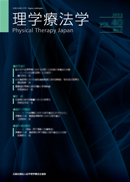All issues

Volume 33, Issue 6
Displaying 1-6 of 6 articles from this issue
- |<
- <
- 1
- >
- >|
Research Reports
-
Yukari OHASHI, Takako YOSHINO, Yoko HONDA, Yukiko OCHIAIArticle type: Article
2006Volume 33Issue 6 Pages 311-317
Published: October 20, 2006
Released on J-STAGE: August 25, 2018
JOURNAL FREE ACCESSIn this study, we conducted a questionnaire survey on students in department of physical therapy in our university to examine the effect of clinical education on their professional identity development. The survey was made in an academic year of 2003 in which our university was incorporating two curriculums; new curriculum for freshman and sophomore and old curriculum for junior and senior. Therefore, we also collected additional data in the academic year of 2005 to clarify an influence of the different curriculum on this study.
Our study showed that professional identity among students tended to be higher in freshman and sophomore than in junior and senior. In addition, encounter with professional role model during clinical education was found effective to increase student's professional identity. Especially, clinical early exposure applied to freshman and sophomore students under the new curriculum increased their opportunity to meet a role model and strengthened their professional identity. However, we need to take possible effects of an educational environment into consideration.View full abstractDownload PDF (970K) -
Takashi NISHIMORI, Akira ITOArticle type: Article
2006Volume 33Issue 6 Pages 318-323
Published: October 20, 2006
Released on J-STAGE: August 25, 2018
JOURNAL FREE ACCESSThis study investigated the trunk motion (including the pelvis) while walking and running in order to provide instruction regarding trunk motion during walking and running for rehabilitation.
The subjects were six male sprinters. Walking and running conditions were as follows: 1.3m/s and 1.9m/s for walking, 2.5m/s, 4.5m/s, 6.5m/s and the maximum speed for running. Walking and running were recorded using three high speed video cameras. The pelvic and trunk angles were measured during pelvic and trunk rotation (transverse plane).
The amplitude of pelvic and trunk rotation during one gait cycle in walking increased significantly with an increase in gait speed (r=0.71, p<0.01, r=0.60, p<0.05), and in running (r=0.72, p<0.005, r=0.87, p<0.005). The relationship of pelvic rotation and trunk rotation showed asymmetry while walking, and the symmetry increased with an increase in speed while running.View full abstractDownload PDF (738K) -
Megumi EZAKI, Takako TANAKA, Takayuki OIKE, Naoto RIKITOMI, Hideaki SE ...Article type: Article
2006Volume 33Issue 6 Pages 324-329
Published: October 20, 2006
Released on J-STAGE: August 25, 2018
JOURNAL FREE ACCESSWe studied 20 individuals with stable chronic lung disease (15 males, mean age=67.6yr), and investigated whether patients' subjective ratings of their walking ability correlate with improvements in objective evaluations. We used Shuttle Walking Test (SWT), 6MWT, ADL score, spirometry, and quadriceps strength as objective evaluations. Moreover, we estimated which improvements in objective evaluations required for patients to report subjective improvement in their walking ability.
We found that only the improvement in SWT distance significantly correlated with patients' subjective ratings (ρ=0.48, p<0.05). Improvement in the mean SWT distance was 35% in the group who had reported subjective improvements in their walking ability, 5% in the group who had reported no change. The results suggest that improvement in SWT distance may be useful to judge the effect of pulmonary rehabilitation program.View full abstractDownload PDF (708K)
Brief Note
-
―A Study in Patients with Stroke, Bone and Joint Disease and Normal Elderly―Motomi Fujiwara, Mika Yamaguchi, Yasuki Tezuka, Tadanobu OtaArticle type: Article
2006Volume 33Issue 6 Pages 330-333
Published: October 20, 2006
Released on J-STAGE: August 25, 2018
JOURNAL FREE ACCESS -
Yuya Seki, Naoto Matsumoto, Kengo Takashima, Takako SekiArticle type: Article
2006Volume 33Issue 6 Pages 334-337
Published: October 20, 2006
Released on J-STAGE: August 25, 2018
JOURNAL FREE ACCESS
Material
-
[in Japanese], [in Japanese], [in Japanese], [in Japanese], [in Japane ...Article type: Article
2006Volume 33Issue 6 Pages 338-352
Published: October 20, 2006
Released on J-STAGE: August 25, 2018
JOURNAL FREE ACCESSDownload PDF (1234K)
- |<
- <
- 1
- >
- >|